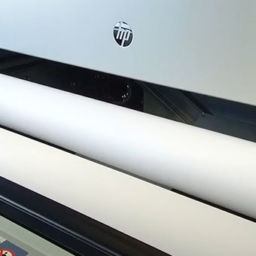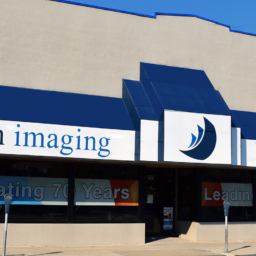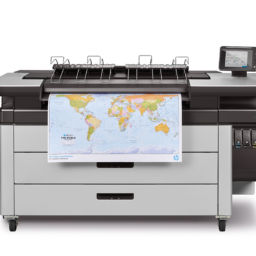By Ed Avis
March 30, 2016
Many reprographics shop owners have been wondering how to profit in the new digital era. Lynn Imaging in Lexington, Kentucky is not wondering – they are doing it already. The company, which is celebrating its 70th anniversary this year, has successfully evolved its business from print-based to digital by offering several quality products that help their clients manage documents.
“We’ve been successful in showing our clients the value of these programs,” says Mike Carter, president of Lynn Imaging. “It’s getting a lot of traction.”
Started in Different Era
Lynn Imaging started life as Lynn Blueprint in 1946. Husband and wife Jack and Marcella Lynn served the needs of builders and surveyors from a 1,000-square-foot location in downtown, Lexington.
By the late 1960s the company, which had a reputation as technologically advanced, began selling HP pen plotters to their customers. Equipment sales continued as an important segment of the business, and it eventually grew to include copiers, scanners, plotters, and surveying equipment.
JL Lynn, Jack and Marcella’s son, joined the business in 1971, and Carter joined the following year. They served the coal boom in the area during the 1970s, and opened several other locations in Kentucky and Ohio.
By 2001 the market was changing. Many of the firm’s clients were seeking digital solutions, and Lynn responded by developing the Digital Plan Room, an e-distribution system that allows clients to better manage the bidding portion of a project.
But they wanted their involvement with their clients to exist beyond the bidding phase. With hardcopy printing becoming a smaller and smaller portion of their business, they looked for a way to remain vital to their clients throughout a building project.
“We wanted to stay more engaged with the project,” Carter says. “As a blueprinter we went through the design and bid management phases, and then we were done.”
New Software Solution
They realized that if they could develop a tool to help their clients manage the flow of documents throughout a project, and close it out at the end, they would be seen as more deeply involved partners in the project.
So Lynn Imaging joined with four other IRgA member firms in non-competing geographies and jointly hired programmers to create a document management system. They visited their clients, and continue to do so, to see exactly what was needed, and what wasn’t. They designed the system to be easily customizable for each client and project.
“To date the customer input is vital to the success of this program,” says Amanda
Schoonover, Mike’s daughter and Lynn Imaging’s director of software technology. “This provides flexibility and customization because every project is different. For example, some customers involve a greater level of detail in projects than other customers, and that’s what we can adapt to.”
The program, called eComm, does not replace the internal software products that the customers are already comfortable with, but it provides them with collaboration tools for multiple team members.
“Basically we made a communications tool where our clients can use their internal products, but when it comes to collaboration on a construction project, our software become the hub,” Carter says. “The system takes the data from all the pieces and put it into a format where they can all pass it back and forth, communicate, and no longer have to use Outlook or email. If it’s something dealing with a project, the whole project team interfaces with it through the system.”
eComm is project-based and can accommodate an unlimited number of users and provides space for an unlimited number of documents. That makes it more efficient for clients, who, if they wanted to manage the documents themselves, would have to buy a certain number of “seats” in a document management system and clear it out after each job.
“The clients are appreciative of less restrictions and better access,” Schoonover says.
And when a construction project is completed, the system creates a concise electronic close-out package that is presented to the owners.
“So now we’re involved from the project inception to close out,” Carter says.
Schoonover agrees: “Where before we received print orders, now we are at the table at the meeting because we know document and workflow management in the construction process,” she says. “Our clients trust us because we are able to contribute to the success of their project.”
Earning a Percentage
Lynn derives revenue from the service by charging a percentage of the total project cost. Setting the pricing as a percentage means the revenue scales up or down in tandem with the size of the project, which makes sense from a work and data-handling perspective, and helps the owner predict costs.
The sales effort is directed at owners, Carter says.
“We were successful in going to owners who had been using our plan room and bid document management tool for years, and we showed them how we can expand on that,” he says. “Because the owners have a lot to gain in controlling the whole document process.”
And of course, once the owners agree to use the tool, all of the contractors and subs use it. In some cases that has led to additional work, as contractors using the system on one project recommend it for other projects.
About two years ago Lynn succeeded in securing a contract with the University of Kentucky to manage the documents for all campus construction, and last July they entered into a contract with the State of Kentucky. The company has managed more than $2 billion in construction projects to date.
Looking Ahead
Today Lynn Imaging, which also has a growing color division called Monster Color, is facing a bright future despite the decrease in paper printing. The third generation of ownership – including Schoonover, Shelby Lynn Marshall, and Justin Carter – is now moving into leadership of the company, and they are leading the continued evolution of the firm from print to digital.
“eComm is one way to help our customers in the digital transformation of their business,” Schoonover says. “We know this can lead to other services to meet our customers’ needs and continue to be relevant as the industry transforms.”
Read the full article here: http://www.irga.com/lynn-imaging-a-digital-success-70-years-in-the-making/





